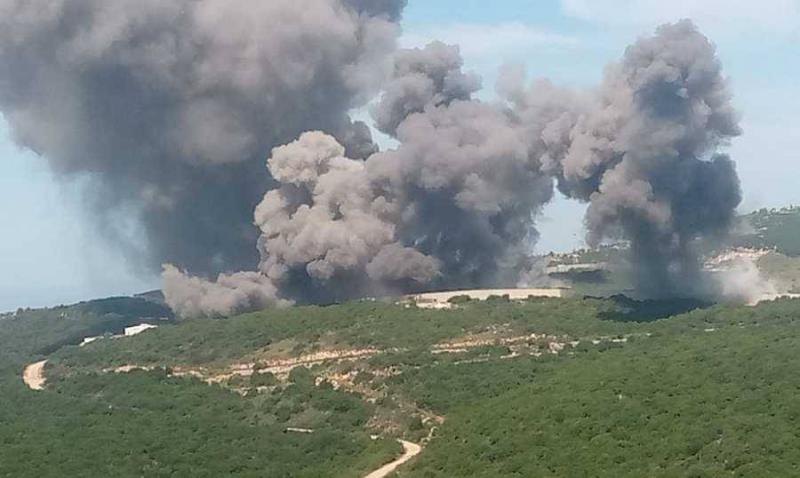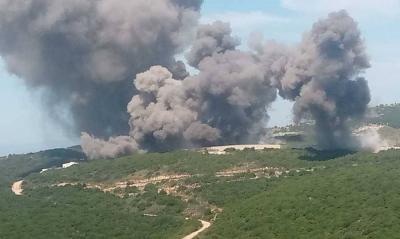A 24-hour period of intense fire and confrontations was witnessed on the southern Lebanese front and the northern Israeli front, following reports from Israeli media that Prime Minister Benjamin Netanyahu had instructed the army to expand and intensify strikes on Lebanon. Hezbollah Downs Drone After a night of violence, during which Israeli aircraft targeted locations in Lebanese villages away from the main conflict zone (the town of Adloun north of the Litani River), confrontations escalated significantly on Saturday. Israel intensified its airstrikes on West Sector villages late Friday-Saturday, resulting in the death of a woman, several injuries, and extensive destruction. In response to this escalation, Hezbollah launched various operations on Saturday, the most notable being the downing of an Israeli drone using a ground-to-air missile, which was seen crashing in southern Lebanon, causing a fire at the site of its fall. The party announced that it had ambushed a drone of the type Hormuz 900, which targets our people and villages, and it was attacked with appropriate weaponry over Lebanese territory where it was downed, according to "Asharq Al-Awsat."
The Israeli army radio confirmed the downing of a Hormuz 900 drone with a surface-to-air missile fired by Hezbollah, noting that the downed drone is one of the largest and most expensive aircraft in the Israeli army. The radio pointed out that this is the fourth time Hezbollah has managed to down an offensive drone since the onset of the war. Significant Damages in Kiryat Shmona Hezbollah also reported targeting the command center of the 769th brigade at the Kiryat Shmona barracks with heavy Burkan missiles, causing a fire to break out there and destroying part of it. The Kiryat Shmona municipality acknowledged that significant damage had occurred to infrastructure, properties, and vehicles due to the missiles falling in the city following Hezbollah's recent missile operation towards the settlement. The municipality clarified that the instructions for Kiryat Shmona residents who remained in the city were to stay close to protected areas.
Moreover, the Israeli army radio admitted that two buildings, one military and one civilian, were hit by missile fire from Lebanon on Kiryat Shmona. In consecutive statements, Hezbollah announced targeting the Al-Baghdadi site, a building holding enemy soldiers in the Natoua colony, newly established espionage equipment at Al-Marj site, artillery positions of the enemy in Khirbet Ma'ar, and the presence of their soldiers in the vicinity.
It announced that it launched an aerial assault with kamikaze drones on a recently established armored faction north of the Yiftah barracks, targeting locations for enemy officers and soldiers. Targeting Motorcycles and Villages At the same time, alongside the expansion of its bombardment of southern villages and towns, Israeli forces returned to focus on targeting motorcycles. The National News Agency reported that a drone executed a strike on a motorcycle on the Acacia Road – Majdel Selm in the Marjeyoun district, while teams from the Islamic Health Authority transferred two injured individuals from the strike site. A guided missile strike also targeted a motorcycle on the main road between Harouf and Jbeshit west of Nabatiyeh. Israeli warplanes bombed the town of Khiam, and Al-Qantara in the Marjeyoun district, and a drone struck near the mosque in the border town of Barin in the western sector, as well as an area near Drdarieh close to Houmine Al-Fawqa. Al-Manar channel affiliated with Hezbollah reported injuries among several Lebanese citizens due to an Israeli strike on Sidqeen in southern Lebanon.
Meanwhile, the Israeli army spokesperson, Avichai Adraei, announced that the war being fought by Hezbollah in support of the 'ISIS' (Hamas) in Gaza costs Lebanon more than $10 million daily, in direct and indirect expenses, according to various research reports. Netanyahu's Motivations Regarding the possibilities of expanding the war between Israel and Hezbollah, Dr. Sami Nader, director of the Middle East Institute for Strategic Affairs, stated that the considerations and objectives of Hezbollah and Israel have become entirely different, especially as Tel Aviv's priority has become the release of hostages, the destruction of Hamas's military capability, and reducing tensions with U.S. President Joe Biden's administration; thus, Netanyahu presented a ceasefire proposal previously accepted by Hamas.
Nader told "Asharq Al-Awsat" that northern Israel has become almost deserted, and thus the isolated area that Israel wanted within Lebanon has now become part of its territory, posing a security and existential threat that drives many to call for expanding the war with Lebanon. He noted that if Netanyahu is trying to prolong the war, feeling cornered in Gaza, he might benefit from the open front with Lebanon as an attempt to break out of the impasse he has reached in Gaza.




